
Vienna 2., Prater Hauptallee
| The Prater Hauptallee is a unique street. Four kilometres long, it leads straight ahead from the Praterstern to the Lusthaus. Before we start our walk, just a few words about the Prater. If a Viennese says "Prater", he usually refers to the "Wurstelprater", Viennas amusement park. But the area of the Prater is actually much bigger. It covers the lowlands and the floodplain forest to the right of the Danube. In 1403 the Prater is mentioned for the first time, in a document written by Albrecht IV. In those times it served as a hunting ground for the Habsburgs. About 1537/38 Emperor Ferdinand I had today's Hauptallee cut down and in 1560 Maximilian II had a fence put around it. Only more than 200 years later Joseph II opened the Prater for the public. After that the Hauptallee had more and more visitors, who used that long street for a nice walk or for even more sportive actions. Today you see people jogging or riding on horses, as well as skateboarders or bikers, or even people, who rent one of the pedalling cars, in order to enjoy the magnificent nature of the area. In 1984 the first "Vienna City-Marathon" was started here. |
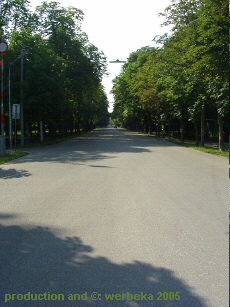 |
But cultural and social history was also written here ... The first workers' demonstration on May 1st, was held in the Hauptallee in 1890. First in 1919 this manifestation was moved to the Ringstraße. At that time this was exemplary for the labour movements in Europe. This is just one of the examples, which counts against the history we learn in school, when we are taught, that Austria was socially and industrially underdeveloped towards the end of the Empire.
This street has even written musical history. Beethoven gave here in 1814 his last public pianoperformance in a cafe. A little more than half a century later, the "Fiakerlied" was created by Gustav Pick, and at the premiere was sung by the famous actor Alexander Girardi. The Fiaker, a carriage, drawn by two horses, still can be seen in the traffic of today, even if it is only rented at festivities or by tourists. Indirectly the song refers to the Hauptallee - the text saying: "Vom Lamm zum Lusthaus fahr' i in zwölf Minuten hin ..." (From the Lamb to the Lusthouse I drive in barely twelve minutes).
|
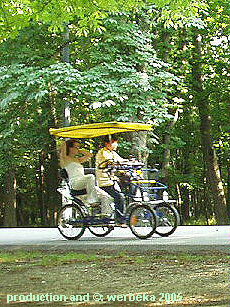 |
The "Lamb" refers to the restaurant "The Golden Lamb" at the Schwedenbrücke, and the Lusthaus is situated at the other end of our street. From this, you can derive that the Fiakers had a velocity of about thirty kilometres per hour at that time, when there wasn't so much traffic. Talking about traffic ... Since 1964 cars are banned from the Hauptallee. Another ban, which had relevance for this street, was established in 1818 - the ban of smoking. Public smoking wasn't looked at very benignly - and today we are following that trend again. There is nothing new under the sun.
Now we have already been walking some distance and left the Wurstelprater behind us. We pass a memorial plaque, which shall remember of the building of Viennas soccer-stadium. In the background, among the trees, we can see the white oval of the former Prater-stadium, which today is dedicated to Ernst Happel, that great defensive player of the fifties and later victorious trainer and national coach. |
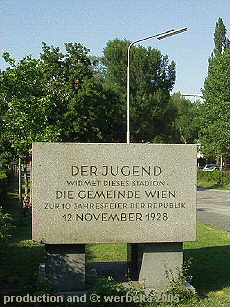 |
The first international soccermatch in the stadium wasn't played before three years later, though, on September 13th, 1931. In those years Austria played very powerful soccer and beat Germany 5-0 in that specific game! But the stadium is used for other sporting events, as well as for music shows.
Soon thereafter we pass an old arm of the Danube, which reminds us that the Danube was flowing wild and freely until 1870, not even a century and a half ago. The river chose its own way and was spreading into many arms in this area. At the regulation in the 19th century a new, 280 m wide river bed was created, the main bed of today. At the same time the flood area on the left bank of the river came into existance, in order to prevent the city from flooding. This helped, but not always. In 1954, at the flooding of my childhood, the Danube had a current of unbelievable 9600 cubic metres - per second(!). That was too much even for the flooding area and so the "New Danube", a second river bed, was built between 1972 - 1988.
|
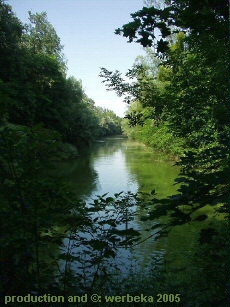 |
| The "Donauinsel" (the island in the Danube) that resulted from this, today is a popular bathing area for the people of Vienna. And the New Danube saved Vienna from another catastrophy in 2002, when the Danube carried even 11000 cubic metres of water per second. That is an equivalent of eleven million litres! Every second ...
We are coming close to the end of the Hauptallee, which is marked by the Lusthaus. It had an antecessor, the "green Lusthaus", which was erected by Maximilian II already in 1566. Today's Lusthaus stands there thanks to Emperor Joseph II, who had Isidore Canevale building it. But as so many other things the Lusthaus was hit by a bomb in 1945 and its rear part was destroyed. Don't forget, that almost with every bomb that falls down anywhere on our world - even today - things are damaged, often more important things than the Lusthaus. And far too often also human life.
© Bernhard Kauntz, Wolvertem 2009
|
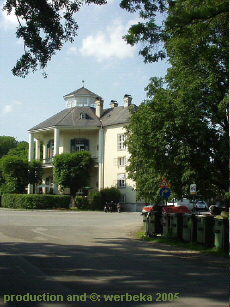 |
Back to  or to the or to the  of of 
19.5.2009 by webmaster@werbeka.com
|

